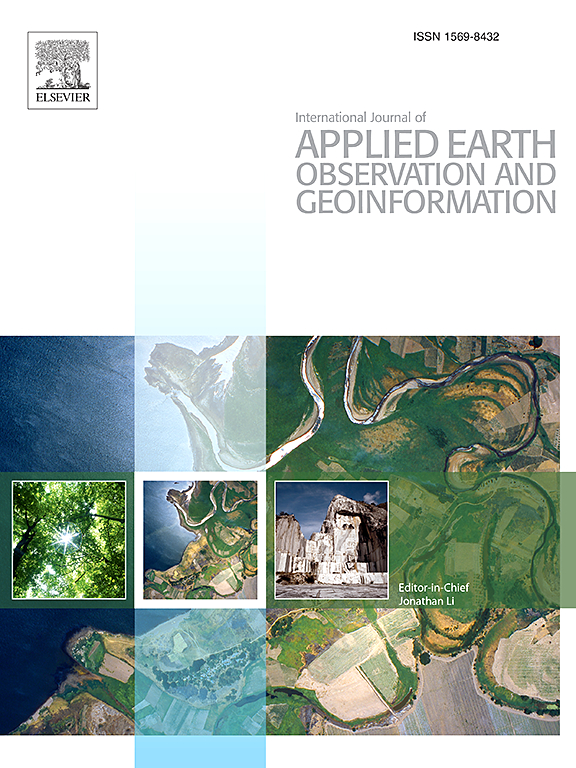RSIT:基于重建海面高度和迭代阈值的沿海高程数据波形重跟踪方法
IF 7.6
Q1 REMOTE SENSING
International journal of applied earth observation and geoinformation : ITC journal
Pub Date : 2025-02-01
DOI:10.1016/j.jag.2024.104346
引用次数: 0
摘要
将卫星雷达测高范围从公海扩展到海岸带,可以提高海岸带海平面监测的精度和质量。然而,雷达测高波形可能会被足迹内观察到的表面特性的任何不均匀性所扭曲,可能导致距离测量误差。针对这些问题,本文提出了一种基于重建海面高度和迭代阈值(RSIT)的海岸回溯方法。RSIT包括以下几个步骤:首先,重建海面高度分量作为先验信息,计算初始重跟踪门;接下来,迭代整个波形的幅度比例因子,以识别可能的子波形。每次迭代后,评估相邻子波形之间的连续性。最后,从所有已识别的子波形中确定最优的重跟踪门。我们在澳大利亚和巴基斯坦的沿海地区使用Jason-2数据验证了RSIT。实验结果表明,与ALES相比,RSIT可以检索到更多的可用高度数据,在距离海岸最后几公里的范围内,精度分别提高了近37.5%和23.1%。此外,还讨论了重建海面高度误差对RSIT的影响,结果表明,RSIT对1 m以内的误差具有较强的鲁棒性,适用于大多数沿海地区。本文章由计算机程序翻译,如有差异,请以英文原文为准。
RSIT: A waveform retracking method based on reconstructed sea surface height and iterative threshold for coastal altimetry data
Extending satellite radar altimetry measurements from the open ocean to the coastal zone can improve the accuracy and quality of monitoring coastal sea level. However, radar altimetry waveforms can be distorted by any inhomogeneity in the properties of the surface observed within the footprints, possibly leading to range measurement errors. To address these issues, a coastal retracking method based on reconstructed sea surface height and iterative threshold (RSIT) is proposed in this paper. RSIT involves several steps: First, the sea surface height components are reconstructed as prior information to compute the initial retracking gate. Next, iterate the amplitude scale factor of the entire waveform to identify possible sub-waveforms. After each iteration, continuity between neighboring sub-waveforms is assessed. Eventually, the optimal retracking gate is determined from all identified sub-waveforms. We validated RSIT using Jason-2 data in the coastal regions of Australia and Pakistan. Experimental results show that RSIT can retrieve more available altimetry data and enhance the accuracy by nearly 37.5% and 23.1% compared to ALES within the last few kilometers to the coast, respectively. Moreover, the impact of varied errors in reconstructed sea surface height on RSIT was discussed, with the results reveal that RSIT has strong robustness to errors within 1 m, making it suitable for application in most coastal zones.
求助全文
通过发布文献求助,成功后即可免费获取论文全文。
去求助
来源期刊

International journal of applied earth observation and geoinformation : ITC journal
Global and Planetary Change, Management, Monitoring, Policy and Law, Earth-Surface Processes, Computers in Earth Sciences
CiteScore
12.00
自引率
0.00%
发文量
0
审稿时长
77 days
期刊介绍:
The International Journal of Applied Earth Observation and Geoinformation publishes original papers that utilize earth observation data for natural resource and environmental inventory and management. These data primarily originate from remote sensing platforms, including satellites and aircraft, supplemented by surface and subsurface measurements. Addressing natural resources such as forests, agricultural land, soils, and water, as well as environmental concerns like biodiversity, land degradation, and hazards, the journal explores conceptual and data-driven approaches. It covers geoinformation themes like capturing, databasing, visualization, interpretation, data quality, and spatial uncertainty.
 求助内容:
求助内容: 应助结果提醒方式:
应助结果提醒方式:


